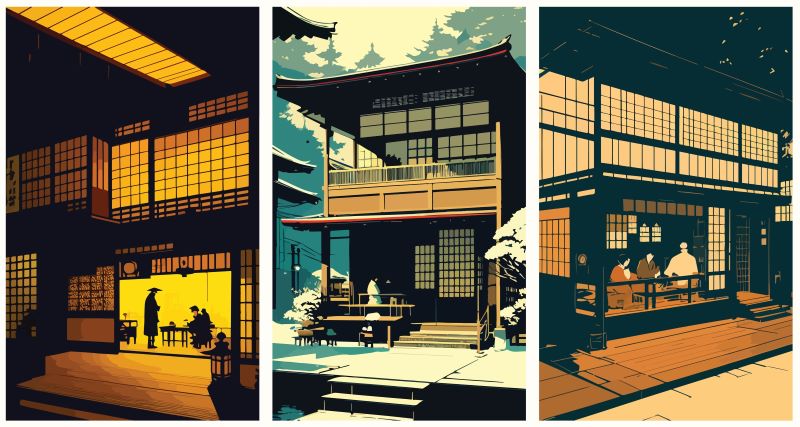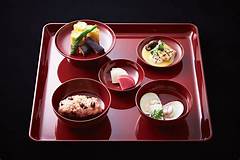In recent years, Japanese kaiseki meal is getting popular and popular worldwide. However do you really understand what’s traditional and ? In this article I would like to introduce the history of traditional kaiseki cuisine, how has kaiseki cuisine changed over time and even gigging into plating tips and techniques. what makes it so fascinating to people?
Table of Contents
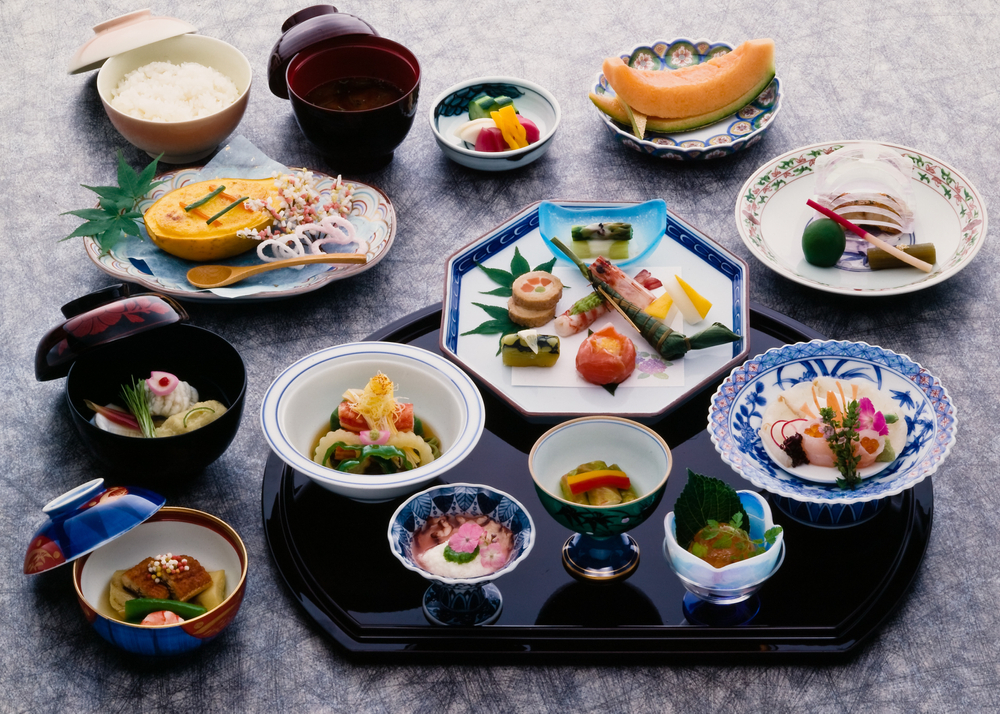
1. Introduction To Japanese Kaiseki Cuisine
Hello there, and welcome to the world of Japanese cuisine! As a chef, it’s important to understand the various styles of cooking and dining experiences in Japanese cuisine. One such style is Kaiseki, a traditional multi-course meal that is not only delicious but also visually stunning. In this article, I’ll explore what Kaiseki is and what makes it unique.
1-1. what is kaiseki?
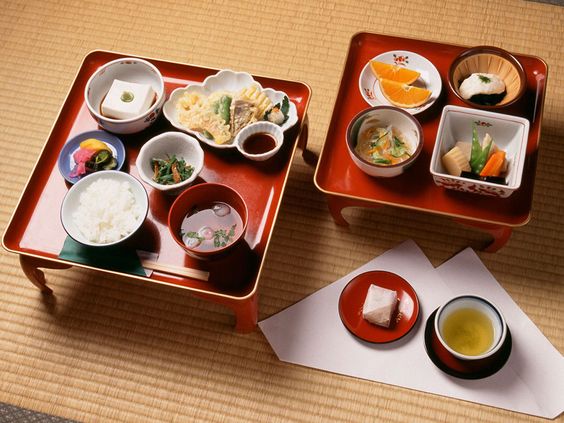
1-2. History and origins of traditional Kaiseki
To truly understand the origins of Kaiseki cuisine, we must travel back in time to ancient Japan. Picture yourself in the 14th century.
<14th century> Honzen-ryori(本膳料理)
Back into 14th century, the end of Muromachi period(室町時代), the concept of “zen-datte”(膳立て) (arrangement of dishes, menu) emerged as a formal style of dining, as depicted in the image on the left.
The “honzen” (本膳)style, represented by this legged tray called “zen,” featured a specific arrangement of dishes. The first tier of the tray, called “ichi-no-zen” (the main tray), would contain a particular set of dishes, followed by the second tier, “ni-no-zen,” which would feature different dishes. Sometimes, this pattern would continue with a third tray, “san-no-zen,” or even a fourth tray, “yo-no-zen.” This format remained prevalent until the Meiji period.
The Muromachi period was a dawn of many cultural arts, including cuisine, and one of its representative aspects was the tea ceremony that originated from Zen Buddhism in Kyoto. The tea ceremony’s accompanying meal, known as chakaiseki(茶懐石), later evolved into the style of kaiseki cuisine. However, the initial tea ceremony meal closely resembled the honzen-style cuisine itself.
<15th century>Kaiseki ryori(懐石料理)
During the Muromachi period through the Azuchi-Momoyama period, Sen no Rikyū introduced the concept of wabi-cha, which led to the refinement and simplification of the honzen-style arrangement. Building upon the principles of yin and yang(陰陽), a unique style of tea ceremony cuisine was developed.
Sen no Rikyū created a new dining style that departed from the traditional “one person, one kind, one plate”(一人一種一器) approach that had been prevalent in Japanese cuisine. Instead, he introduced a method called “hachi-mori,” which involved serving multiple dishes in a communal bowl or platter for sharing among the guests.
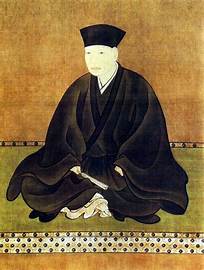
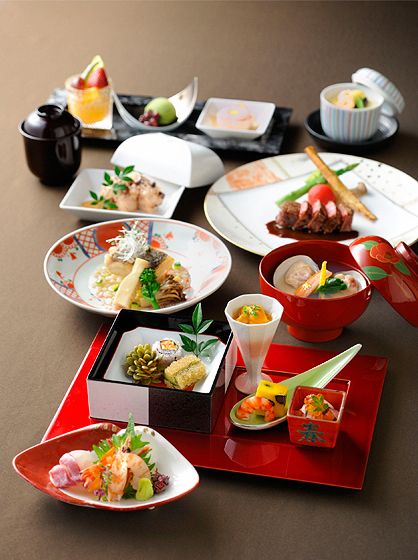
<16th century> edo-period(江戸時代)
Merchants in Kyoto and Osaka created a new type of establishment known as “ryōtei” (料理茶屋, lit. cooking teahouse) as social gathering places in the cities.
The dishes that were previously served for meals have transformed into dishes that accompany alcoholic beverages, known as “sake cuisine” or “izakaya cuisine,” and have taken on the form we see today.
Kaiseki Ryori 【会席料理】2 Types
1. Served at Restaurant
Enjoy with food and sake (alcohol)
- Served at Tea ceremony
Kaiseki(懐石)or Chakaiseki(茶懐石)
Small amount of meal served Before the tea ceremony
Well, “kaiseki” refers to a gathering of people, typically a small group, and the cuisine served at such gatherings is called “kaiseki cuisine【会席料理】.” There are two main types of kaiseki cuisine: the one served at restaurants and the one served at tea ceremonies. The kaiseki cuisine served at tea ceremonies is called “kaiseki(懐石)” or “chakaiseki(茶懐石).” In this context, “kaiseki” refers to a light Japanese meal that is served to accompany tea, ensuring that guests do not consume strong tea on an empty stomach and can fully appreciate the flavors of the tea.
Over time, Kaiseki grew in popularity and started to stand on its own as a distinct culinary tradition. The concept of incorporating seasonal ingredients and showcasing their natural flavors and beauty became an integral part of Kaiseki. This focus on nature’s bounty was deeply rooted in the appreciation of the changing seasons—a fundamental aspect of Japanese culture.
| Aspect | Kaiseki (懐石) | Kaiseki (会席) |
| Culinary Style | Traditional | Elaborate and formal |
| Setting | Tea ceremony | Banquets or formal events |
| Ingredients | Simple and natural | More complex and elaborate |
| Presentation | Artful and minimalistic | Elaborate and decorative |
| Occasion | Intimate and small gatherings | Large gatherings or events |
| Focus | Fresh, seasonal, and local ingredients | Complex and varied dishes |
| Courses | Multi-course meal | Multi-course meal |
| Emphasis | Mindfulness, simplicity, and respect for nature | Formality and grandeur |
1.3 What are the key principles and philosophy of Kaiseki cuisine?
Kaiseki cuisine embodies several essential principles and a profound philosophy. Let me share them with you.
- simplicity
- Balance
- Ichigo-Ichie(一期一会)
Simplicity ....
Instead of relying on elaborate techniques or heavy seasoning, Kaiseki embraces the purity of flavors. It seeks to bring out the natural essence of each ingredient, allowing them to shine individually and collectively.
Balance ....
Balance is also crucial in Kaiseki. Every dish is thoughtfully composed, considering taste, texture, color, and even the vessel in which it is served. The goal is to achieve a harmonious balance between these elements, creating a visually captivating and well-rounded dining experience.
Ichigo Ichie (一期一会) ....
Kaiseki values the concept of “Ichigo-Ichie,” which means “one opportunity, one encounter.” It emphasizes the unique nature of each dining experience, emphasizing that every moment is special and cannot be replicated. Kaiseki encourages diners to fully immerse themselves in the present moment, cherishing the flavors and the atmosphere created by the chef.
2. Multi-course dining experience of Kaiseki
Step into the enchanting realm of Kaiseki, a traditional Japanese dining experience that takes you on a delightful journey through the seasons. In this section, we will explore two important aspects of Kaiseki cuisine: the use of fresh seasonal ingredients and the number of courses typically served. Let’s embark on a culinary adventure where nature’s bounty and exquisite flavors come together to create an unforgettable dining experience.
1-1 Seasonal ingredients and menu changes
At the heart of Kaiseki cuisine lies a deep appreciation for the ever-changing seasons and the remarkable produce they bring. Kaiseki chefs draw inspiration from nature, crafting their menus to showcase the finest ingredients available during each season. From delicate spring blossoms to vibrant summer vegetables, autumn’s rich harvest, and the tranquility of winter, every season offers its own unique flavors and textures.
Here is an article talking about seasonal ingredients typically used in Japanese kaiseki cuisine. I hope it helps you to understand.
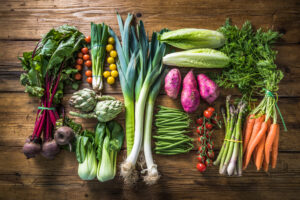
Useful Japanese Seasonal ingredients
Let's dave in to learn what kind of ingredients are popular and rare to use in Japanese Kaiseki course.
1-2 How many courses are typically served in Kaiseki cuisine?
A hallmark of the Kaiseki dining experience is the indulgence in multiple courses meticulously designed to take diners on a gastronomic voyage. While the number of courses can vary, a traditional Kaiseki meal often consists of several courses, ranging from 6 to 15 or more.
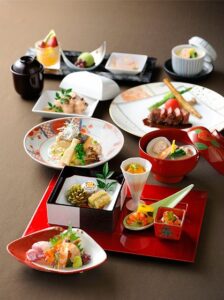
Mastering Japanese kaiseki courses
A Kaiseki course typically served in 6-15 dishes. From appetizers to main courses and desserts, learn about the traditional structure.
3. The art of Kaiseki presentation
Step into a world where culinary artistry meets visual splendor – the captivating realm of Kaiseki presentation. In here, we will embark on a journey that explores the two essential elements that elevate Kaiseki dining to a multisensory experience: plating techniques and aesthetics, as well as the role of ceramics and tableware.
1-1. Plating techniques and aesthetics
One key difference between Japanese plating and that of many other countries is the concept of creating “empty space” or “margin” on the dish. To achieve this, the essence lies in cutting away the excess. It can be described as a culture of “subtraction,” a principle that extends to various forms of art and entertainment in Japan.
First of all, in Japanese cuisine, there is always a focal point and a front side. The dish placed at the focal point is the main component, and side dishes are arranged to the right and front of it, complementing the overall presentation. When plating, the “Kamigata” **(上方)dishes have more empty space surrounding them, while “Edo” dishes have less empty space but showcase a clear contrast in height, expressing a refined and sophisticated aesthetic.
*Kamigata ryori(上方料理)… The description refers to Kyoto cuisine, which is made using ingredients such as dried foods, vegetables, tofu, yuba (tofu skin), fu (wheat gluten), and white-meat fish. Sometimes this term also includes Osaka cuisine, which heavily incorporates seafood. These dishes are seasoned with light soy sauce and dashi (broth), and white miso is commonly used as a seasoning.
Secondly, in the finishing touches, for dishes presented in a bowl (“wanmori/椀盛り”), a “uwamori/上盛り” (small garnish placed on top) is used.
For “tsukuri/造り” or “sashimi/刺身” (sliced raw fish), it is accompanied by “ashirai/あしらい” (decorative garnish).
Grilled dishes and other preparations may be accompanied by “maemori/前盛り” (served in front of the main dish) or “kuchinaoshi-mono/口直し物” (palate cleansers) to complete the meal.
Futhermore, an essential technique in presenting dishes to make them look more appetizing is the use of scalene triangles to construct the arrangement on the plate’s surface. By arranging the elements in scalene triangles, a sense of harmony and unity is achieved in the presentation. Whether plating a single dish or multiple dishes, this technique requires skill and expertise, and it takes practice and experience to master.
1-2. The role of ceramics and tableware in kaiseki presentation
In the Jananese cuisine, there are 3 main types of dishes
- Tea ceremonies (chakaiseki・茶懐石)
- Banquet meals (kaiseki/会席)
- Everyday home use(家庭用)
In the past, one could instinctively understand the appropriate usage of dishes by simply looking at them. For example, tea ceremony dishes exuded an elegant and serene atmosphere, conveying a sense of Wabi/Sabi(詫び・寂び).
On the other hand, dishes used in restaurants displayed a certain stylishness with a subtle touch of sophistication. As for dishes used in households, practicality was emphasized, taking into account factors such as family composition and everyday usability.
The fundamental shape for these dishes is “Round”The round shape represents “真”, while variations in shape are represented by the characters for “行” and “草.”
“真行草” is a term used in Japanese calligraphy that refers to the three styles of writing Chinese characters: kaisho (block), gyosho (semi-cursive), and sosho (cursive). It is also used in other traditional Japanese art forms such as tea ceremony, flower arrangement, and poetry
Therefore, chefs use round dishes to practice their plating skills. Without mastering the art of proper presentation, one cannot create beautiful arrangements with bowls, irregularly shaped dishes, or large plates.
The use of the potter’s wheel in ceramic production began in Japan around the ancient 13th century. Later, during the early Edo period (about 400 years ago) when porcelain production started, the Japanese potter’s wheel techniques had become remarkable.

Using the potter’s wheel allows the creation of round jars, bowls, and plates, referred to as “yang-shaped” vessels. In Japanese cuisine, the assumption is that all dishes are served in these yang-shaped vessels. As a result, the trays or stands used to hold these vessels have an “yin-shaped” form, characterized by square shapes with right angles. The combination of these yin and yang elements results in a harmonious presentation.
In the early Edo period, as Japanese porcelain became more widespread, decorative plates started to be created, and eventually, they became popular all over Japan. Before this development, Japanese cuisine primarily followed the “one person, one dish” or “one dish, one item” serving style. However, with the emergence of the “kyō no zen” (興の膳) style, dishes were presented on a single plate with multiple items, moving away from the traditional one-item-per-dish approach.
4. How to eat kaiseki
Japanese cuisine is renowned worldwide for its delicate flavors, exquisite presentation, and deep-rooted cultural significance. Among the various traditional dining experiences in Japan, Kaiseki stands out as a true embodiment of culinary artistry. Rooted in the principles of harmony, balance, and respect for nature, Kaiseki offers a unique and immersive gastronomic journey that transcends mere sustenance. In this article, we delve into the world of Kaiseki cuisine, exploring proper etiquette and manners, tips for enjoying the experience, and how to fully appreciate the nuances of this culinary art.
1-1. Proper Etiquette and Manners when Dining on Kaiseki Cuisine
Kaiseki dining is a refined and ritualistic experience, and adhering to the proper etiquette and manners is crucial to fully embrace the tradition. Here are some essential etiquettes to keep in mind:
①Arrival and greeting
Upon arriving at the restaurant, it is customary to offer a polite greeting to the staff. A simple “Konnichiwa” (Hello) with a slight bow is a respectful way to start your meal.
②Seating and Seiza
Traditionally, Kaiseki is served in a tatami-mat room with low tables. You may be required to sit in the formal Japanese style known as “seiza(正座),” which involves kneeling with your legs folded beneath you. If you find it uncomfortable, you can politely request a cushion or opt for a regular chair if available.
③Appreciate the Presentation
Kaiseki cuisine is not just about taste; it’s also about visual aesthetics. Take a moment to admire the carefully arranged dishes before indulging in them.
④Chopstick Etiquette
Avoid sticking your chopsticks vertically into a bowl of rice, as this resembles a funeral ritual in Japanese culture. (This is big no no!) Instead, rest them horizontally on a chopstick-rest or the side of the plate.
⑤Slurping
Unlike in some cultures where slurping is considered impolite, it is acceptable and even encouraged to slurp noodles in Japanese cuisine, as it indicates that you are enjoying the dish.
⑥Soy Sauce Usage
I know you love soy sauce. But when using soy sauce for dipping, do so sparingly and avoid drowning the delicate flavors of the dishes. Show respect for the chef’s artistry by tasting the natural essence of each course.
⑦Finishing the Meal
In Japanese culture, it’s appreciated if you finish your meal entirely, leaving no food behind. This conveys your gratitude and respect for the chef’s efforts. And, the end of the meal, you should say “Gochisousamadeshita!”☻
1-2. Tips for Enjoying the Kaiseki Experience
To truly savor the Kaiseki experience, consider the following tips
①seasonality
Kaiseki menus are curated to reflect the changing seasons, utilizing the freshest seasonal ingredients. Embrace the connection to nature and appreciate the seasonal flavors in each dish.
②Engage with the Chef
If possible, sit at the counter where you can watch the chef prepare your meal. Engaging with the chef allows you to gain insight into the craftsmanship and dedication that goes into each dish. Nowadays, many restaurants in Japan are tolarate of speaking English so you may enjoy having a conversation with chefs.
③Savor Each Course
Take your time to appreciate and savor each course. Kaiseki is not a rushed meal; it’s meant to be savored slowly, allowing you to experience a diverse range of flavors and textures.
④Pairing with Sake
Consider pairing your Kaiseki meal with traditional Japanese sake. The delicate and nuanced flavors of sake can complement the subtlety of Kaiseki cuisine, enhancing your dining experience.
⑤Open Mind
Embrace the adventurous spirit of Kaiseki by trying new and unfamiliar ingredients. Be open to experiencing flavors and textures you may not encounter in other cuisines.
5. The Best Kaiseki restaurant in Japan
For those with a passion for culinary exploration, Japan is nothing short of paradise. The country boasts an extensive array of Kaiseki restaurants, ranging from hidden gems tucked away in traditional neighborhoods to opulent establishments gracing the heart of metropolitan cities. Each restaurant, led by a masterful chef, weaves together a symphony of seasonal ingredients, delicate flavors, and captivating presentations, promising an unforgettable sensory experience.
The Daunting Choice
As we delve into the world of Kaiseki, the sheer abundance of options can be overwhelming for even the most seasoned food enthusiasts. The discerning diner is faced with the challenge of choosing from an ever-expanding list of exceptional venues, each offering its interpretation of Kaiseki perfection. The question lingers – how does one narrow down the choices to find the crème de la crème?
The Allure of Michelin Stars
To navigate the labyrinth of Kaiseki restaurants, many turn to the esteemed Michelin Guide. This prestigious culinary guide has long been the gold standard for recognizing top-tier dining establishments worldwide. Within the world of Kaiseki, a Michelin star signifies an extraordinary level of mastery, precision, and creativity.
A restaurant adorned with Michelin stars not only promises an exceptional meal but also guarantees an exploration of Japan’s culinary traditions and innovation at its finest. These stars serve as beacons for travelers and food enthusiasts seeking an unparalleled Kaiseki adventure.
Introducing Three Useful Websites for Kaiseki Exploration
To aid in the quest for the best Kaiseki restaurant in Japan, here are three invaluable websites that offer insights, reviews, and recommendations: (click to their website)
6. differences between kaiseki and other japanese experiences
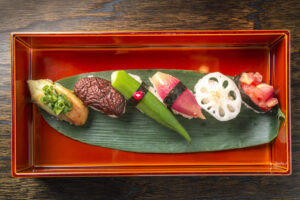
Differences Between Kaiseki and Other Japanese dining Experiences
Exploreand examining how it differs from sushi or other Japanese cuisine, what sets it apart from other fine dining experiences, and the various approaches.
7. The future of Kaiseki cuisine
1. How Kaiseki Cuisine is Evolving
Kaiseki cuisine, deeply rooted in history and tradition, is now witnessing an exciting evolution. While preserving its core principles of seasonality, balance, and artistry, contemporary Kaiseki chefs are introducing new elements and techniques to surprise and delight diners.
a) Fusion of Flavours
Modern Kaiseki chefs are fearlessly experimenting with diverse ingredients and flavors, infusing traditional dishes with international influences. Imagine savoring a classic Kaiseki course with a delightful twist, blending Japanese flavors with a touch of Mediterranean or South American flair.
From Tokyo to New York, chefs are seeking out authentic Japanese ingredients to elevate their dishes. Essential elements like miso, soy sauce, mirin, dashi, and yuzu are finding their way into diverse cuisines. These ingredients bring a unique umami depth and complexity that chefs are eager to explore. The subtlety of Japanese flavors adds a touch of sophistication to both traditional and contemporary dishes, creating a memorable dining experience.
b) Embracing Technology
While honoring tradition, Kaiseki is also embracing modern technology to enhance the dining experience. From innovative presentation techniques to interactive digital menus that provide insight into the ingredients’ origins, technology is harmoniously blending with tradition in the world of Kaiseki.
2. The Influence of Kaiseki Cuisine on Global Fine Dining Trends
Kaiseki’s influence has transcended borders, inspiring chefs and food enthusiasts worldwide. Its impact on global fine dining trends is nothing short of remarkable.
a) Emphasis on Seasonality
Kaiseki’s focus on seasonal ingredients and dishes has become a cornerstone of modern fine dining across the globe. Chefs in renowned restaurants now craft menus that change with the seasons, celebrating the freshest produce each time.
b) Omakase Experience
Kaiseki’s “omakase” dining style, where the chef curates a personalized meal for each guest, has gained popularity worldwide. (Seriously everywhere!) This personalized touch allows diners to trust the chef’s expertise fully and embark on a culinary adventure without preconceived notions.
c) Umami and Flavor Enhancement
Umami, known as the “fifth taste,” is highly prized in Japanese cuisine. Chefs worldwide are learning from Japanese culinary masters about how to unlock and enhance umami in their own dishes. Techniques such as fermenting, drying, and aging are being incorporated to heighten flavors and add depth to various preparations.
d)Minimalism and Precision
Japanese cooking techniques are renowned for their precision and minimalism. Global chefs are adopting these approaches to achieve clean, uncluttered presentations that allow the ingredients to shine. The focus on simplicity and attention to detail create visually appealing dishes that resonate with diners seeking an elevated gastronomic experience.
E) Culinary Cross-Pollination
The blending of Japanese and other international cuisines is taking place across the globe. Chefs are experimenting with cross-cultural combinations, such as Japanese-Italian or Japanese-Peruvian fusion. These culinary experiments result in surprising and delightful taste profiles, appealing to adventurous diners seeking new and exciting flavors. that resonate with diners seeking an elevated gastronomic experience.
Summary...
The trend of world chefs incorporating Japanese ingredients and cooking techniques into their culinary creations is undeniably on the rise. The allure of umami, the finesse of Japanese culinary techniques, and the growing interest in health and sustainability have all played a part in making Japanese cuisine a global culinary inspiration. As this trend continues to grow, we can look forward to more delightful fusions and innovative dishes that celebrate the best of Japan’s culinary traditions in harmony with the diverse flavors of the world.
